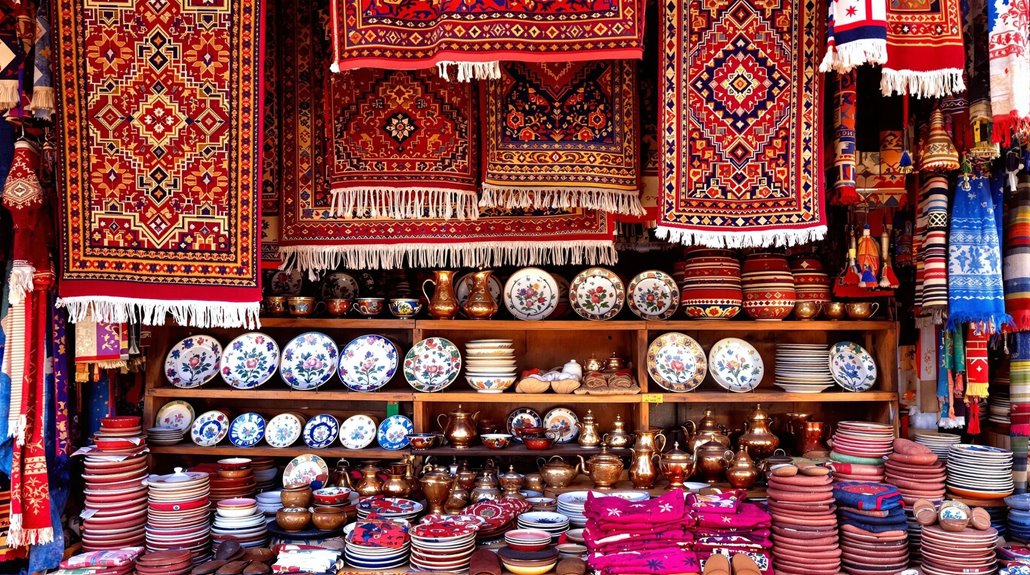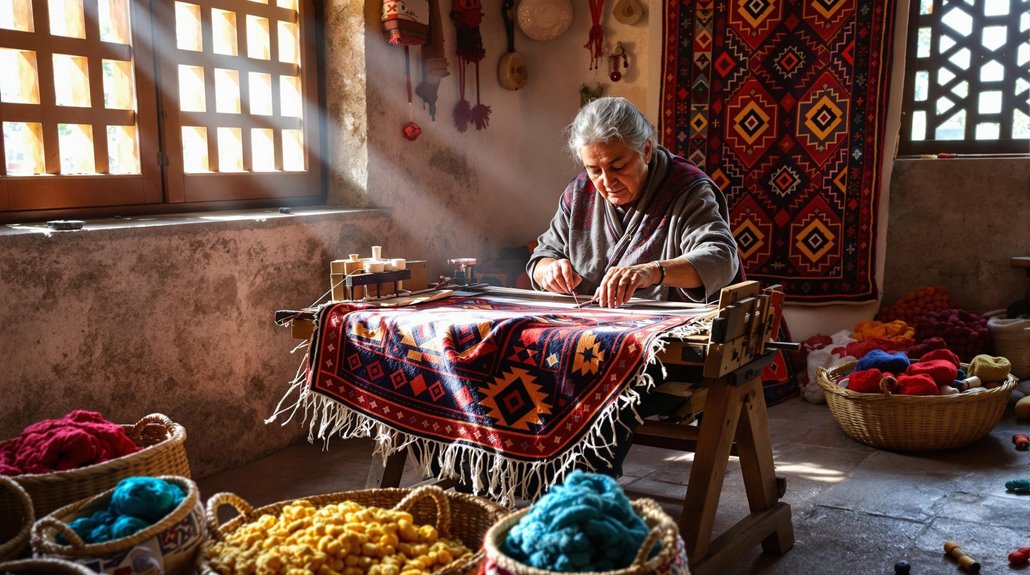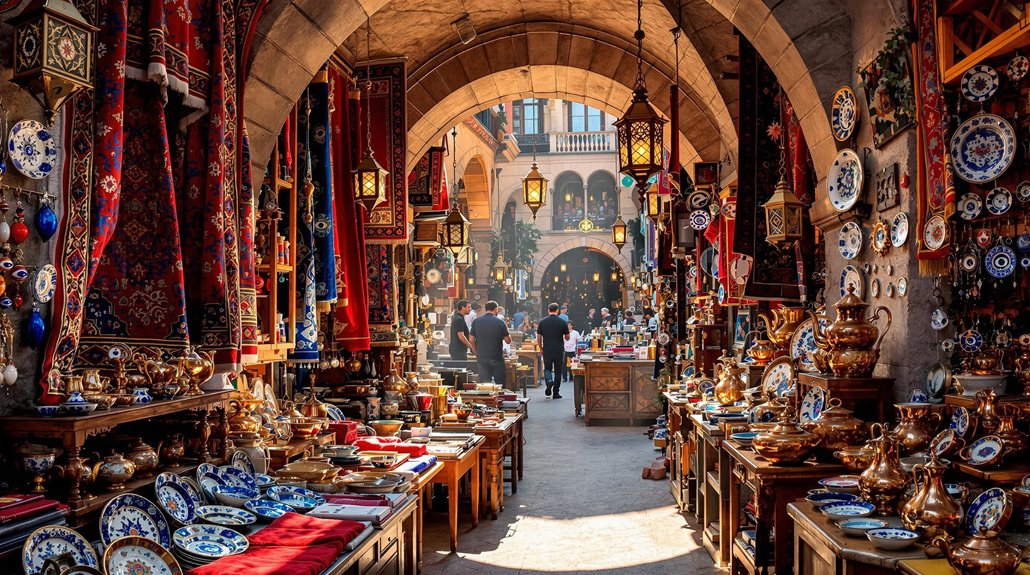What Are the Primary Handmade Crafts Produced in Turkey?

Turkey's most celebrated handmade crafts include intricate ceramics and tiles, ornate copper metalwork, and deftly woven textiles like kilims and rugs. You'll find exquisite woodcarvings featuring geometric patterns, while decorative arts showcase the Ottoman legacy through tezhip (illumination) and miniature paintings. These time-honored traditions, passed down through generations of skilled artisans, reveal fascinating stories of cultural heritage and artistic excellence that span over four millennia.
The Ancient Art of Turkish Ceramics and Tiles
While many ancient civilizations left their mark through architecture and writing, Turkey's cultural legacy shines through its exceptional ceramic and tile artistry spanning over four millennia. You'll find this rich cultural heritage preserved in landmarks like the Ottoman-era Sultan Ahmed Mosque, where stunning Iznik tiles showcase intricate patterns of flora, fauna, and geometric designs in vibrant blues and reds. Turkish ceramics stand out for their exceptional strength, thanks to the distinctive red paste made from local soil.
Today, you can investigate this artistic tradition at specialized museums in Kütahya and Istanbul, where centuries of ceramic expertise are on display. UNESCO's recognition of Iznik tiles on their World Heritage Tentative List further confirms the enduring significance of this craft that began in ancient Mesopotamia and continues to flourish in dynamic Turkey. The Çanakkale ceramic tradition emerged in the late 1600s, distinguished by its use of thick red or beige-colored clay and distinctive horse-topped lids.
Traditional Metalworking: Turkish Coppersmithing Excellence
Since the Seljuk Turks brought their metalworking competence from Central Asia to Anatolia, Turkish coppersmithing has flourished as one of the nation's most distinctive crafts. You'll find this Traditional art form widely used throughout modern Turkey, with adept artisans still practicing ancient techniques like tavlama, a unique method of heating and smoothing copper.
The rich legacy of Turkish metalworking can be examined through:
- Ornate copper coffee pots (cezve) that showcase intricate designs
- Decorative pepper grinders found in local bazaars
- Masterful pieces combining copper with brass and iron work
- Heritage Handicrafts passed down from the Seljuk Turks
While Turkish artisans work with various metals, including gold and silver, it's their coppersmithing that truly distinguishes them, reflecting centuries of competence dating back to the Ottoman Empire. Similar to their renowned leather crafting expertise, Turkish artisans blend traditional techniques with contemporary designs to create unique metalwork pieces.
Turkish Textile Heritage: Weaving and Kilim Making

Beyond the metalworking traditions, Turkey's artistic heritage shines brilliantly through its textile craftsmanship. You'll find that Turkish rugs and kilims represent some of the oldest crafts in the country's cultural legacy, with origins traced back to ancient Çatalhöyük. These Traditional Turkish Handicrafts showcase intricate designs and natural dyes that have captured global attention.
In towns like Buldan, you'll uncover the living heritage of textile production, where artisans create delicate handwoven fabrics for traditional hammam towels. The rich weaving tradition employs various materials, from luxurious silk to durable wool and wool-cotton blends. Local Anatolian communities have preserved these time-honored techniques, ensuring that Turkey's textile heritage continues to thrive through their skillful creation of kilims and carpets, each piece telling a unique story of Turkish culture. The slitweave technique used in Anatolian kilims creates distinctive geometric patterns that have become hallmarks of Turkish textile artistry.
The Mastery of Turkish Woodcarving
Turkish woodcarving represents one of the most sophisticated artistic traditions in Anatolia, with roots deeply embedded in Seljuk craftsmanship. When you explore Turkish arts, you'll discover how Seljuk Turks dominated the art of transforming wood into intricate designs featuring:
- Geometric patterns of octagons and diamonds
- Delicately carved star motifs
- Expertly crafted mosque doors and niches
- Intricately designed cupboards and furniture
This traditional handicraft continues to thrive today, with skilled experts maintaining the legacy of their ancestors. From the time of Ottoman Turks until now, woodcarving has remained a crucial source of income for artisans who've perfected techniques like kündekari. You'll find these masterful creations throughout Turkey, where the tradition of working with wood showcases the remarkable precision and artistic vision that's defined Anatolian craftsmanship for centuries. Much like the rich cultural heritage seen in Turkish handbags, these woodcarvings represent generations of artisans pouring their hearts into every detailed piece.
Decorative Arts: Embroidery, Oya, and Quilt-Making

As decorative arts flourished throughout Anatolia, three distinct crafts emerged as pillars of cultural expression: embroidery, oya lace-making, and quilt-making.
Traditional crafts in Turkey showcase intricate details passed down from generation to generation. Turkish embroidery, rooted in nomadic heritage, features stunning geometric and floral patterns, while the Adana and İçel regions are renowned for their distinctive bead embroidery work. You'll find oya, a delicate form of lace, adorning women's clothing and household items across the region.
Turkish quilts represent both practical craftsmanship and decorative art. While everyday quilts made from satin or printed cotton can be completed in just 1.5 days, professional quilt-making remains a respected craft dating back to Ottoman times. You can still find skilled quilters practicing their trade in select bazaars and neighborhoods throughout Turkey.
Ottoman Legacy: Tezhip and Miniature Painting
Exemplars of Ottoman artistry emerge through two distinctive crafts: tezhip and miniature painting. This rich history dates back to the 9th century and remains an important cultural legacy throughout Turkey. Tezhip, using gold as its commonly used metal, adorns manuscripts with intricate floral patterns.
You'll find these traditional arts preserved in different parts of the country, where skilled artisans continue practicing these time-honored techniques:
- Manuscript decoration using gold leaf and natural pigments
- Detailed illustrations of courtly life and historical events
- Intricate painting on egg-glazed paper with organic dyes
- Ornate floral motifs blending with calligraphic elements
Master artists like Mustafa Çelebi, Süleyman Çelebi, and Levni perfected these crafts during the Ottoman Empire's golden age, particularly in the 15th-16th centuries, creating works that continue to inspire modern artisans.
Regional Craft Centers and Modern Artisan Markets

While Ottoman artistic traditions live on through tezhip and miniature painting, modern Turkey's lively craft scene flourishes in distinct regional centers. You'll uncover unique arts and crafts hubs across the country, from the historic Grand Bazaar near Sultan Ahmed and the Blue Mosque to the ancient pottery workshops of Cappadocia, where ceramic-making traditions date back to the Bronze Age and Roman Empire.
In Iznik, you'll find specialized tile-making workshops producing their signature blue-and-white designs, while Kütahya's artisans craft exquisite porcelain with traditional Ottoman patterns. Beyond the major centers, you can investigate vibrant artisan markets in Ankara, Bursa, and coastal towns, where local craftspeople sell everything from handwoven kilim rugs and walking sticks to embroidered textiles and intricate copperware.




